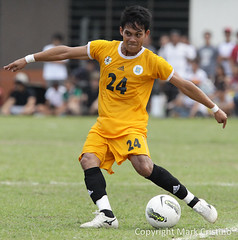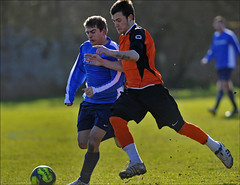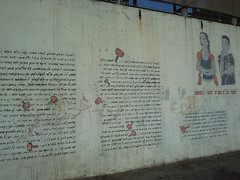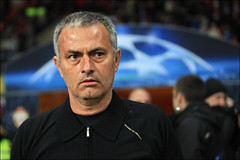Did you know...
Fencer Giuseppe Delfino won the gold medal in the individual épée at the 1960 Summer Olympic Games. He was the 6th Italian épée fencer in a row to win the Olympic title.
English Football Results
In the 20th century, three Italians won the Alpine World Cup. They were Gustavo Thoeni (1971, 1972, 1973, 1975), Piero Gros (1974) and Alberto Tomba (1995). Thoeni became the first skier to win four world titles.
Interesting Facts About Italy's Sports
Italy -the winner of the 2006 World Cup- has qualified for the 2010 FIFA World Cup in South Africa. The Italian men's soccer team will be the second European team to participate in nine consecutive World Cups.
In 1925, Ottavio Bottecchia (cyclist ) won the Tour de France for the second consecutive year. Ottavio became the first Italian to win the French tournament.
Italy will send 80 (or 100) athletes to the Youth Olympic Games in 2010. The national team will probably compete in athletics, basketball, boxing, fencing, gymnastics, judo, sailing, shooting, swimming, weightlifting and wrestling.
Federica Pellegrini (swimming /200m freestyle & 400m freestyle ) has amassed several international trophies. At the 2008 Olympic Games in China, Federica -country's most famous sportswoman- helped Italy to its first women's swimming gold. She could win a second gold medal in London 2012.
Diver Klaus Dibiasi -1st in the World Championships, 1975- is the only diver to win 3 consecutive Olympic diving gold medals (Mexico'68, West Germany '72, Canada '76).
From 1924 to 2006, Italy has won 101 winter Olympic medals, including 36 gold. Italy has more winter Olympic medals than Japan, China, Hungary, Russia, France...
Rome will host the FINA World Championships in 2009. About 2,200 swimmers from over 180 countries and territories are expected to compete in 66 events.
Many American athletes have Italian origin: Joe DiMaggio (baseball), David Scalabrine (basketball), Anthony Fasano (American football), Chris DiMarco (golf ), Tony Granato (ice hockey), Mario Andretti (auto racing), Charlie Colombo (soccer), Matt Biondi (swimming), Jennifer Capriati (tennis), Young Corbett III (boxing), Mary Lou Retton (gymnastics), Mike Gallo (baseball), Thomas James Gugliotta (basketball), Julia Mancuso (skiing), Rocky Marciano (boxing).
Domenico Fioravanti (2000 Olympic 100 & 200-meter breaststroke gold medalist ) and Federica Pellegrini (Olympic 100m freestyle gold medalist in 2008) were trained by Alberto Castagnetti. Alberto is one of the best swimming coaches in the world.
The first Olympic gold medal for an Italian female athlete was won at the 1936 Olympics. During these Games, Trebisonda Valla, or simply known as Ondina Valla, won the gold medal in the 80m hurdles.
Italian athlete Andrew Howe won the silver medal in the long jump at the IAAF World Championships in 2007. He was born in Los Angeles, California (USA).
Turin -It is one of the oldest cities in the world- hosted the 80th edition of the World Fencing Championships. The World Championships were one of the best tournaments in 2006. "Turin fencers had been entertaining the thought of having the elite of world fencing back in our city for some time", Cesare Salvatore (president of the organizing committee) told one interviewer. "They asked me if I would be the president of the organizing committee, because I had won the team competition in the 1972 Olympic Games with Italy after winning the silver medal in 1964 and 1968, and I agreed..."
Primo Nebiolo was one of the best Olympic leaders in the 20th century. From 1981 to 1999, Nebiolo was the head of the International Athletic Federation (IAAF). He is also considered the father of the World University Games-the second largest multi-sport event in the world. Nebiolo was born on July 14, 1923, in Turin, Italy.
In 1952, Nino Farini became the first European to win the Formula 1 world title.
Giovanni Benvenuti -who is known as Nino Benvenuti to his fans- became the gold medalist in the welterweight (67kg / 147 lbs) division at the Summer Olympic Games in 1960. Seven years later, he won the world championship.
Three Italians have won the New York City Marathon: Orlando Pizzolato (1984 & 1985), Giacomo Leone (1996), and Franca Fiacconi (1998).
Italian Bruna Mautino Vargas -the daughter of two Peruvian athletes- is one of Europe's best young volleyball players. Under her leadership, Italy -European champion- qualified for the semi-finals at the FIVB Girls' Youth World Championship in 2007. She -captain of the youth team- hopes to compete in the 2012 Olympic Games in the United Kingdom. Bruna -1.80m tall- was born on November 30, 1990, in Lima (Peru), the daughter of Giuliana Vargas -who won a bronze medal at the 1983 Pan American Games- and Marco Mautino-who was a sprinter in the 1980s. When she is not playing, she enjoys listening to music and spending time with her family. Bruna also likes Peruvian food. This sportswoman speaks four foreign languages (Italian, Spanish, English, French). Her idol is Mauro Camoranesi (Italian football player).
The 1920 Olympic Fencing Tournament was dominated by Italy. This European country won five Olympic fencing golds -individual foil, team épée, team foil, individual saber, team saber- at the Olympiad in Antwerp (Belgium). Italy's Nedo Nadi was elected the best fencer.
The Italian team won 10 medals -2 golds, 6 silvers, 2 bronzes- at the Winter Olympic Games in 1998. Italy ranked 11th among 72 nations and territories.
Stefano Baldini became the second Italian to win the Olympic marathon gold medal. He won the marathon at the 2004 Summer Olympics in Athens (Greece). Results:
1.Baldini, Stefano ( Italy ) 2:10.55
2.Keflezighi, Meb ( United States) 2:11.29
3.Lima, Vanderlei ( Brazil ) 2:12.11
4.Brown, Jon ( United Kingdom ) 2:12.26
5.Aburaya, Shigeru ( Japan ) 2:13.11
6.Wainaina, Erick (Kenya ) 2:13.30
7.Chaica, Alberto ( Portugal )
The Italian men's waterpolo team -European champion, 1947- won the Olympic title in 1948. Italy won the Olympic tournament again in 1960.
Italy has hosted several sports events:
1898: Shooting World Championships
1902: Cycling World Cup
1902: Shooting World Championships
1911: Cycling World Championships
1911: Shooting World Championships
1930: Shooting World Championships
1932: FIS Alpine World Ski Championships
1934: FIFA World Cup
1939: Cycling World Cup
1941:FIS Alpine World Ski Championships
1951: Cycling World Championships
1953: FILA Wrestling World Championships
1954: Gymnastics World Championships
1955: Fencing World Cup
1956: Winter Olympic Games
1956:FIS Alpine World Ski Championships
1959: Summer Universiade
1960: Summer Olympics
1961: Fencing World Cup
1962: Cycling World Championships
1963: Mediterranean Games
1966: Winter Universiade
1970: World University Games
1970: FIS Alpine World Ski Championships
1973: Baseball Intercontinental Cup
1975: World University Games
1975: Winter Universiade
1976: Cycling World Championships
1978: FIVB World Championships
1978: Baseball World Cup
1981: IAAF World Cup
1982: Fencing World Cup
1985: Winter Universiade
1985: FIS Alpine World Ski Championships
1985: FiVB Under-21 World Championship
1987: IAAF World Championships
1987: FIBA Under-21 World Championship
1988: Baseball World Cup 1990: FIFA World Cup
1990: FILA Wrestling World Championships
1991: FIFA Under-17 World Cup
1993: Baseball Intercontinental Cup
1993: FINA Women's Water Polo World Cup
1994: FINA World Championships
1997: Mediterranean Games
1997: World University Games
1997: FIS Alpine World Ski Championships
1998: Baseball World Cup
1999: ICF Flatwater Racing World Championships
2001: IHF Women's Handball World Cup
2003: Winter Universiade
2004: IAAF World Junior Championships
2005: FIS Alpine World Ski Championships
2006: Winter Universiade
Pietro Mennea won the gold medal in the men's 200-meter at the 1980 Games in Russia. He was the third European to win the 200m. The gold medal by Italy's Pietro was not a surprise to the journalists, sports fans and sportswriters. Why? Pietro Mennea set a new world mark on September 12, 1979 at the World University Games in Mexico City, when he ran the 200-meters in 19,72 seconds.
Italy -It is about the size of the state of Arizona- has played an active role in the Modern Olympic Movement.This European nation has participated in 25 Summer Olympics:
Olympiad...............Gold...........Silver........Bronze...........Total.......Ranking
Athens 1896..............0..............0...............0.........................0...................
Paris 1900................2..............2...............0.........................4...............8
St.Louis 1904........Did not compete.......................................................
London 1908.............2..............2...............0.......................4...............9
Stockholm 1912.........3..............1..............2......................6.............11
Antwerp 1920...........13...............9..............9....................31...............7
Paris 1924.................8..............3..............5......................16................5
Amsterdam 1928.......7..............5..............7....................19................5
Los Angeles 1932.....12............12............12.................36................2
Berlin 1936................8.............9...............5.....................22...............4
London 1948..............8............11.............8....................27...............5
Helsinki 1952.............8.............9..............4....................21...............5
Melbourne 1956..........8.............8.............9....................25................5
Rome 1960.............13............10............13....................36................3
Tokyo 1964..............10............10.............7....................27................5
Mexico 1968..............3..............4............9......................16.............13
Munich 1972.............5..............3..........10......................18.............10
Montreal 1976...........2...............7............4.....................13..............14
Moscow 1980............8..............3.............4.....................15...............5
Los Angeles 1984.....14.............6...........12..................32..............5
Seoul 1988...............6..............4............4......................14.............10
Barcelona 1992.........6..............5............8....................19.............12
Atlanta 1996.............13............10............12.................35...............6
Sydney 2000............13..............8............13.................34...............7
Athens 2004.............10............11...........11.................32..............8
Beijing 2008..............8.............10...........10.................28..............9
Interesting Facts About Italy's Sports














